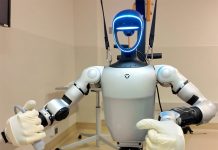
Imagine having an extra thumb to help you with daily tasks.
Cambridge researchers have found that people can quickly learn to use a controllable, prosthetic third thumb to pick up and manipulate objects.
This exciting study, published in Science Robotics, highlights the potential of new motorized devices to enhance our abilities.
The research team tested the robotic thumb on a diverse group of people to ensure that the technology is inclusive and works for everyone.
This approach is crucial to make sure that everyone, including marginalized communities, benefits from new technological advances.
Motor augmentation, which includes using devices like exoskeletons or extra robotic body parts, can help healthy individuals boost their productivity and provide new ways for people with disabilities to interact with their environment.
Professor Tamar Makin from the Medical Research Council (MRC) Cognition and Brain Sciences Unit at the University of Cambridge emphasizes the need to consider inclusivity from the early stages of research and development. By doing so, we can ensure that everyone has the chance to benefit from these innovations.
Dani Clode, a collaborator in Professor Makin’s lab, created the Third Thumb. This extra robotic thumb is designed to increase the wearer’s range of movement, improve grasping capability, and expand the hand’s carrying capacity.
The Third Thumb is worn on the opposite side of the palm to the biological thumb and is controlled by pressure sensors placed under the big toes. Pressing with the right toe moves the thumb across the hand, while pressing with the left toe moves it towards the fingers.
In 2022, the team tested the Third Thumb at the Royal Society Summer Science Exhibition. Over five days, they tested 596 participants aged three to 96 from various backgrounds.
Only four participants had difficulty using the thumb due to fit or control issues. Most participants could use the device within a minute, demonstrating its ease of use.
Participants completed two tasks. In the first task, they used the Third Thumb to pick up pegs and place them in a basket within 60 seconds.
In the second task, they used the Third Thumb and their biological hand to move foam objects of different shapes. Almost everyone succeeded in using the thumb immediately, with 98% able to manipulate objects within the first minute.
Performance varied among participants, but there were no significant differences between genders or handedness. Interestingly, people who might be considered skilled with their hands, like musicians, did not perform better at the tasks.
Older adults showed a decline in performance with age, likely due to general sensorimotor and cognitive declines. Younger children also found it more challenging, particularly those under ten years old.
Dani Clode explains that augmentation aims to create a new relationship with technology, making it an extension of the body. For this to work, the design stage must be inclusive, ensuring that devices are accessible and easy to use for everyone.
Co-author Lucy Dowdall adds that successful motor augmentation needs to seamlessly integrate with the user’s abilities, considering factors like age, gender, lifestyle, and even personal preferences. Testing diverse groups is essential to achieve this goal.
Inclusive design is critical to avoid technological failures. For example, speech recognition systems often struggle with non-white voices, and augmented reality technologies can be less effective for users with darker skin tones.
Women face higher health risks in car accidents due to safety features designed primarily for men. Tools designed for right-hand use have caused accidents among left-handers. By focusing on inclusivity, we can create better and safer technologies for everyone.
Source: University of Cambridge.



